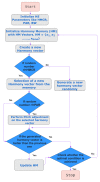Generation of Synthetic Chest X-ray Images and Detection of COVID-19: A Deep Learning Based Approach
- PMID: 34069841
- PMCID: PMC8157360
- DOI: 10.3390/diagnostics11050895
Generation of Synthetic Chest X-ray Images and Detection of COVID-19: A Deep Learning Based Approach
Abstract
COVID-19 is a disease caused by the SARS-CoV-2 virus. The COVID-19 virus spreads when a person comes into contact with an affected individual. This is mainly through drops of saliva or nasal discharge. Most of the affected people have mild symptoms while some people develop acute respiratory distress syndrome (ARDS), which damages organs like the lungs and heart. Chest X-rays (CXRs) have been widely used to identify abnormalities that help in detecting the COVID-19 virus. They have also been used as an initial screening procedure for individuals highly suspected of being infected. However, the availability of radiographic CXRs is still scarce. This can limit the performance of deep learning (DL) based approaches for COVID-19 detection. To overcome these limitations, in this work, we developed an Auxiliary Classifier Generative Adversarial Network (ACGAN), to generate CXRs. Each generated X-ray belongs to one of the two classes COVID-19 positive or normal. To ensure the goodness of the synthetic images, we performed some experimentation on the obtained images using the latest Convolutional Neural Networks (CNNs) to detect COVID-19 in the CXRs. We fine-tuned the models and achieved more than 98% accuracy. After that, we also performed feature selection using the Harmony Search (HS) algorithm, which reduces the number of features while retaining classification accuracy. We further release a GAN-generated dataset consisting of 500 COVID-19 radiographic images.
Keywords: COVID-19 detection; chest X-ray; deep learning; feature selection; generative adversarial network; harmony search; synthetic data generation.
Conflict of interest statement
The authors declare no conflict of interest. The funders had no role in the design of the study; in the collection, analyses, or interpretation of data; in the writing of the manuscript, or in the decision to publish the results.
Figures









Similar articles
-
CovidGAN: Data Augmentation Using Auxiliary Classifier GAN for Improved Covid-19 Detection.IEEE Access. 2020 May 14;8:91916-91923. doi: 10.1109/ACCESS.2020.2994762. eCollection 2020. IEEE Access. 2020. PMID: 34192100 Free PMC article.
-
AI-driven deep convolutional neural networks for chest X-ray pathology identification.J Xray Sci Technol. 2022;30(2):365-376. doi: 10.3233/XST-211082. J Xray Sci Technol. 2022. PMID: 35068415
-
Deep Learning Algorithm for COVID-19 Classification Using Chest X-Ray Images.Comput Math Methods Med. 2021 Nov 9;2021:9269173. doi: 10.1155/2021/9269173. eCollection 2021. Comput Math Methods Med. 2021. PMID: 34795794 Free PMC article.
-
DL-CRC: Deep Learning-Based Chest Radiograph Classification for COVID-19 Detection: A Novel Approach.IEEE Access. 2020 Sep 18;8:171575-171589. doi: 10.1109/ACCESS.2020.3025010. eCollection 2020. IEEE Access. 2020. PMID: 34976555 Free PMC article.
-
Data augmentation using Generative Adversarial Networks (GANs) for GAN-based detection of Pneumonia and COVID-19 in chest X-ray images.Inform Med Unlocked. 2021;27:100779. doi: 10.1016/j.imu.2021.100779. Epub 2021 Nov 22. Inform Med Unlocked. 2021. PMID: 34841040 Free PMC article.
Cited by
-
Analysis of CT scan images for COVID-19 pneumonia based on a deep ensemble framework with DenseNet, Swin transformer, and RegNet.Front Microbiol. 2022 Sep 23;13:995323. doi: 10.3389/fmicb.2022.995323. eCollection 2022. Front Microbiol. 2022. PMID: 36212877 Free PMC article.
-
A two-tier feature selection method using Coalition game and Nystrom sampling for screening COVID-19 from chest X-Ray images.J Ambient Intell Humaniz Comput. 2023;14(4):3659-3674. doi: 10.1007/s12652-021-03491-4. Epub 2021 Sep 22. J Ambient Intell Humaniz Comput. 2023. PMID: 34567278 Free PMC article.
-
Cardiovascular/Stroke Risk Stratification in Diabetic Foot Infection Patients Using Deep Learning-Based Artificial Intelligence: An Investigative Study.J Clin Med. 2022 Nov 19;11(22):6844. doi: 10.3390/jcm11226844. J Clin Med. 2022. PMID: 36431321 Free PMC article. Review.
-
Economics of Artificial Intelligence in Healthcare: Diagnosis vs. Treatment.Healthcare (Basel). 2022 Dec 9;10(12):2493. doi: 10.3390/healthcare10122493. Healthcare (Basel). 2022. PMID: 36554017 Free PMC article.
-
Binary Simulated Normal Distribution Optimizer for feature selection: Theory and application in COVID-19 datasets.Expert Syst Appl. 2022 Aug 15;200:116834. doi: 10.1016/j.eswa.2022.116834. Epub 2022 Mar 15. Expert Syst Appl. 2022. PMID: 36034050 Free PMC article.
References
-
- Chen N., Zhou M., Dong X., Qu J., Gong F., Han Y., Qiu Y., Wang J., Liu Y., Wei Y., et al. Epidemiological and clinical characteristics of 99 cases of 2019 novel coronavirus pneumonia in Wuhan, China: A descriptive study. Lancet. 2020;395:507–513. doi: 10.1016/S0140-6736(20)30211-7. - DOI - PMC - PubMed
-
- Toussie D., Voutsinas N., Finkelstein M., Cedillo M.A., Manna S., Maron S.Z., Jacobi A., Chung M., Bernheim A., Eber C., et al. Clinical and chest radiography features determine patient outcomes in young and middle-aged adults with COVID-19. Radiology. 2020;297:E197–E206. doi: 10.1148/radiol.2020201754. - DOI - PMC - PubMed
-
- Shen B., Hoshmand-Kochi M., Abbasi A., Glass S., Jiang Z., Singer A., Thode H., Li H., Hou W., Duong T. Initial chest radiograph scores inform COVID-19 status, intensive care unit admission and need for mechanical ventilation. Clin. Radiol. 2021;76:473.e1–473.e7. doi: 10.1016/j.crad.2021.02.005. - DOI - PMC - PubMed
Grants and funding
LinkOut - more resources
Full Text Sources
Miscellaneous

